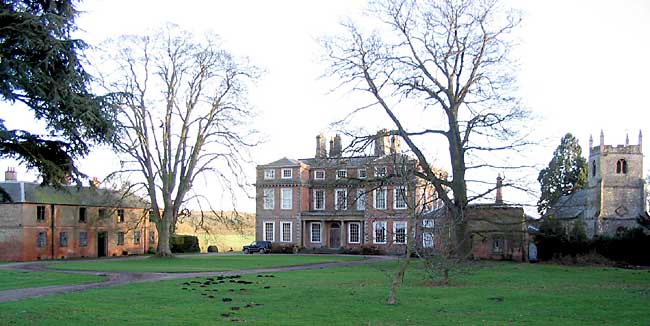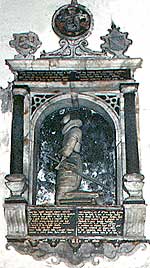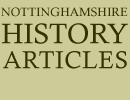County families and mansions: Winkburn Hall
By L Craven Smith-Milnes

Winkburn Hall has been attributed to William Smith of Warwick and dates from c.1695 (Photo: A Nicholson, 2005).
WINKBURN Hall lies some few miles north-east of Southwell, off the Hockerton-Kirklington road. From this side it is approached through a spacious park, in one corner of which stands the house, raised upon a series of terraced lawns, set with low-treaded steps, marked, as is the garden wall, with stone urns. Several fine trees throw their shade across the greensward, among them a copper beech which is said to be the largest in England.
The present hall dates back to William and Mary, nothing remaining of the earlier Manor House save some panelling incorporated in the present structure. Considerable additions were made in 1840, the mansard roof, with its dormer windows, being replaced by the present top story, which gives a sense of baldness to the line of the building seen against the sky. The tall, square-paned windows, suggest high, square rooms, typical of eighteenth century domestic architecture, and these rooms are embellished with some fine Adams fireplaces. That in the library has inset a carved panel representing a tropical scene, wherein sailors from a three-master vessel, anchored off shore, are seen busy with the work of replenishing their water supply. The whole suggests a Dutch inspiration. The series of carved panels above each of the doorways in the central hall, however, are very English. Representing scenes from "Aesop's Fables," they may be described as a "feature" of Winkburn.

One of the fine Adams fireplaces.
The back staircase, with turned spindles and thick oak treads is in strong contrast to the main stair, which is something of an oddity. On first acquaintance one would take it to be a piece of finely carved "Empire" work, with boldly scrolling acanthus stems; but this is not so. The work is cast-iron, but so well done that only a close examination and cold touch will reveal the deception.
The whole of the curtains and bed hangings of one room are wool-embroidered in Jacobean style, while in other chambers are preserved early chintzes, a tribute to the fine quality of these printed fabrics.
Winkburn is stated by Thoroton to have been held by Swayne before the Conquest and under the Normans one of the manors of the family of de Tyson.
The church and village and a large area of woods are mentioned in the earliest records. Adam de Tyson conveyed the whole manor to the Knights Hospitallers of St. John of Jerusalem. The property is mentioned in detail in a report which Prior Philip de Thame made to the Grand Master, in 1338, and the Order remained in possession until the dissolution. King Henry the Eighth then conferred the manor on Thomas Burnell in exchange for estates at Eastbeachworth in Surrey.
This Thomas Burnell was a merchant of Saint Olave's Tower Ward in the City of London, and apparently connected with a family of that name at Acton Burnell in Shropshire, who bore for their arms "a lion sable rampant crowned or, a bordure," whereas Thomas, the merchant, had a grant or confirmation of his arms dated the 27th August, 1529, which states: "And he, the said Thomas Burnell hath tenderly prayed and required me the said King of Armes to make good and thorough serche for the verray armes of his predecessours at whose instance I have condesscyded me so to doo with all goodly diligence and have found that the right armes of the said Thomas Burnell and his predecessours have been goold and silver endented par fece, a lion rampant sable armed langed and a bordure platee." The Shropshire Burnells were Lords of Beldwas Castle at the Conquest and in 1283 the King held a Parliament at Acton Burnell in the castle of Robert Burnell who was then the Lord Keeper and also Bishop of Bath and Wells.
At this sitting an Act was passed called de mercatoribus or the Statute of Burnell.
King Henry the Eighth died before his agreement to confer Winkburn on Thomas Burnell could be carried into effect, but King Edward the Sixth granted a charter to his son, William Burnell, who was auditor to King Henry the Eighth. This charter is dated the 19th of July, 1549, and is a grant of the Manor, Rectory, Church and advowson of Winkburn, Mausey Wood containing 88 acres, East Spring Wood 46 acres, Park Wood 26 acres, Coppe Wood 26 acres, the Rectory, Church and advowson of Maplebeck, the advowson of the Church of Calcebye in Lincolnshire and the hamlets of Winkburn, Maplebeck and Calcebye.

Monument to Acton Burnell who died in 1609 (photo: A Nicholson, 1988).
Mention is made of the usual rights of the Lord of the Manor such as probate of wills, assays of bread, goods of felons and fugitives, and provision is made for the payment of ten shillings yearly to John Aynesvor, the keeper of the woods and of Four pounds, sixteen shillings and eightpence yearly to be paid the Curate performing Divine Service in the Church of Maplebeck for his stipend. The William Burnell to whom this charter was granted died in 1570 and his tomb is near the altar of the church. His younger brother, Edward, married the widow of Richard Whalley and died in 1589. There is a fine alabaster monument in Sibthorpe Church erected by his wife.
William Burnell, second Lord of the Manor, died in 1609 and has a curious monument on the wall of the church. He is represented in armour in a kneeling posture and has a long sword of metal.
The inscription on the monument tells us with pride the alliances he secured for his four daughters: Olive to William Wombwell of Wombwell; Elizabeth to Sir William Cave, Knight, of Stamford; Jane to Robert Markham, of Cotham, and Dorothy to Gervas Strelley, of Beauchief Abbey.
Edward Burnell, one of his younger sons, was knighted in the Scots wars and married the widow of Willoughby of Towton.
